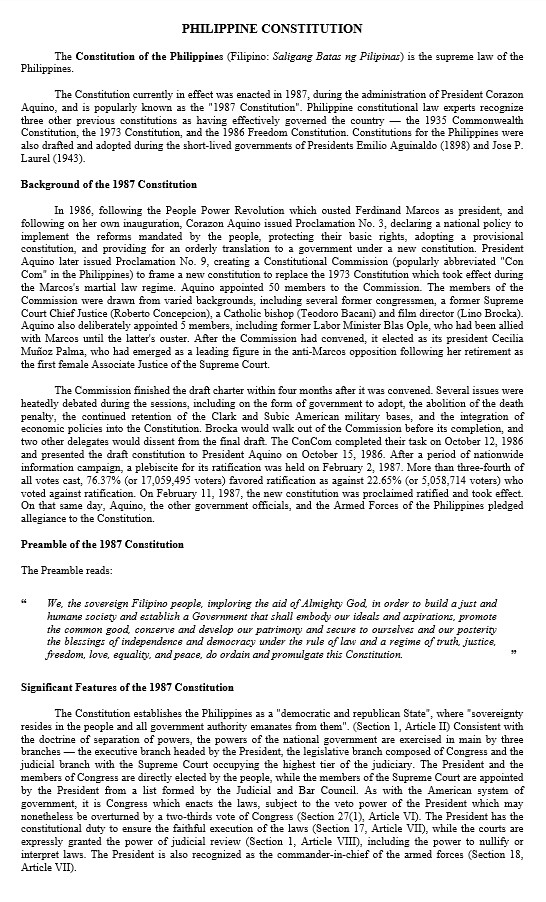1987 Philippine Constitution (Law and Politics)
Summary:
The 1987 Philippine Constitution, also known as the Saligang Batas ng Pilipinas, serves as the supreme law of the Philippines. It was enacted during President Corazon Aquino’s administration following the People Power Revolution, which ousted Ferdinand Marcos. The constitution establishes the Philippines as a democratic and republican state, with sovereignty residing in the people. It outlines the structure of the government, including the separation of powers among the executive, legislative, and judicial branches. The President and members of Congress are directly elected, while the President appoints Supreme Court members. The Constitution also grants limited political autonomy to local government units and enshrines various state policies and protections for citizens’ rights, including a Bill of Rights.
Historically, the Philippines has had several other constitutions, including the 1935 Commonwealth Constitution, the 1973 Constitution, the 1986 Freedom Constitution, the 1897 Constitution of Biak-na-Bato, and the 1899 Malolos Constitution.
Excerpt:
1987 Philippine Constitution (Law and Politics)
PHILIPPINE CONSTITUTION
The Constitution of the Philippines (Filipino: Saligang Batas ng Pilipinas) is the supreme law of the Philippines.
The Constitution currently in effect was enacted in 1987, during the administration of President Corazon Aquino, and is popularly known as the “1987 Constitution”. Philippine constitutional law experts recognize three other previous constitutions as having effectively governed the country — the 1935 Commonwealth Constitution, the 1973 Constitution, and the 1986 Freedom Constitution. Constitutions for the Philippines were also drafted and adopted during the short-lived governments of Presidents Emilio Aguinaldo (1898) and Jose P. Laurel (1943).
Background of the 1987 Constitution
In 1986, following the People Power Revolution, which ousted Ferdinand Marcos as president, and following her own inauguration, Corazon Aquino issued Proclamation No. 3, declaring a national policy to implement the reforms mandated by the people, protecting their basic rights, adopting a provisional constitution, and providing for an orderly translation to a government under a new constitution. President Aquino later issued Proclamation No. 9, creating a Constitutional Commission (popularly abbreviated “ConCom” in the Philippines) to frame a new constitution to replace the 1973 Constitution, which took effect during Marcos’s martial law regime. Aquino appointed 50 members to the Commission.


Reviews